4-6-6-4 "Challenger" Locomotives: Photos, History, Survivors
Last revised: November 4, 2024
By: Adam Burns
The Challenger Type, characterized by its articulated design, stands as one of the most successful large wheel arrangements in history.
This engineering marvel was initially developed for Union Pacific in their quest to build a more powerful locomotive capable of hauling significant loads over steep grades at greater speeds.
The railroad, foreseeing the potential of this design, expanded its fleet to include an impressive 105 Challengers. These 4-6-6-4s were among the technological pinnacles of their era, blending high horsepower with efficient operations to redefine locomotive performance standards.
Despite their advanced capabilities and critical acclaim, the big engines - much like their Yellowstone counterparts - experienced a relatively brief operational lifespan, marking a poignant chapter in the history of steam railroading.
Most of these impressive locomotives were decommissioned after less than twenty years of service—a few even before reaching their first decade. Throughout their operational years, they graced the tracks of nine different railroads.
However, the legacy of the Challenger was not completely lost to history. From 1981 to 2011, enthusiasts and historians had the unique opportunity to experience one of these iconic locomotives in action.
Union Pacific #3985, miraculously preserved, served not only as a moving museum piece but also as an active participant in railroading. Alongside its contemporary, 4-8-4 #844/4, #3985 was a star attraction, pulling excursion and business trains across the UP system, allowing new generations to witness a bygone era of steam railroading.
With the acquisition and restoration of "Big Boy" #4014, the venerable #3985 was retired once more. However, it was not destined to remain silent in the annals of railroading. Housed within the historic environs of the Cheyenne, Wyoming roundhouse, #3985 was poised for a resurgence.
On April 28, 2022, it was announced this iconic locomotive would be donated to the Railroading Heritage of Midwest America. This esteemed non-profit organization is headquartered in the former Rock Island shops in Silvis, Illinois, and is also responsible for operating the celebrated Milwaukee Road 4-8-4 #261.
With plans to conduct a full overhaul, the organization aims to breathe new life into #3985, preparing it to grace the rails once again in excursion service. This initiative ensures that the Challenger will continue to enchant and educate future generations about the golden age of steam railroading.
Photos
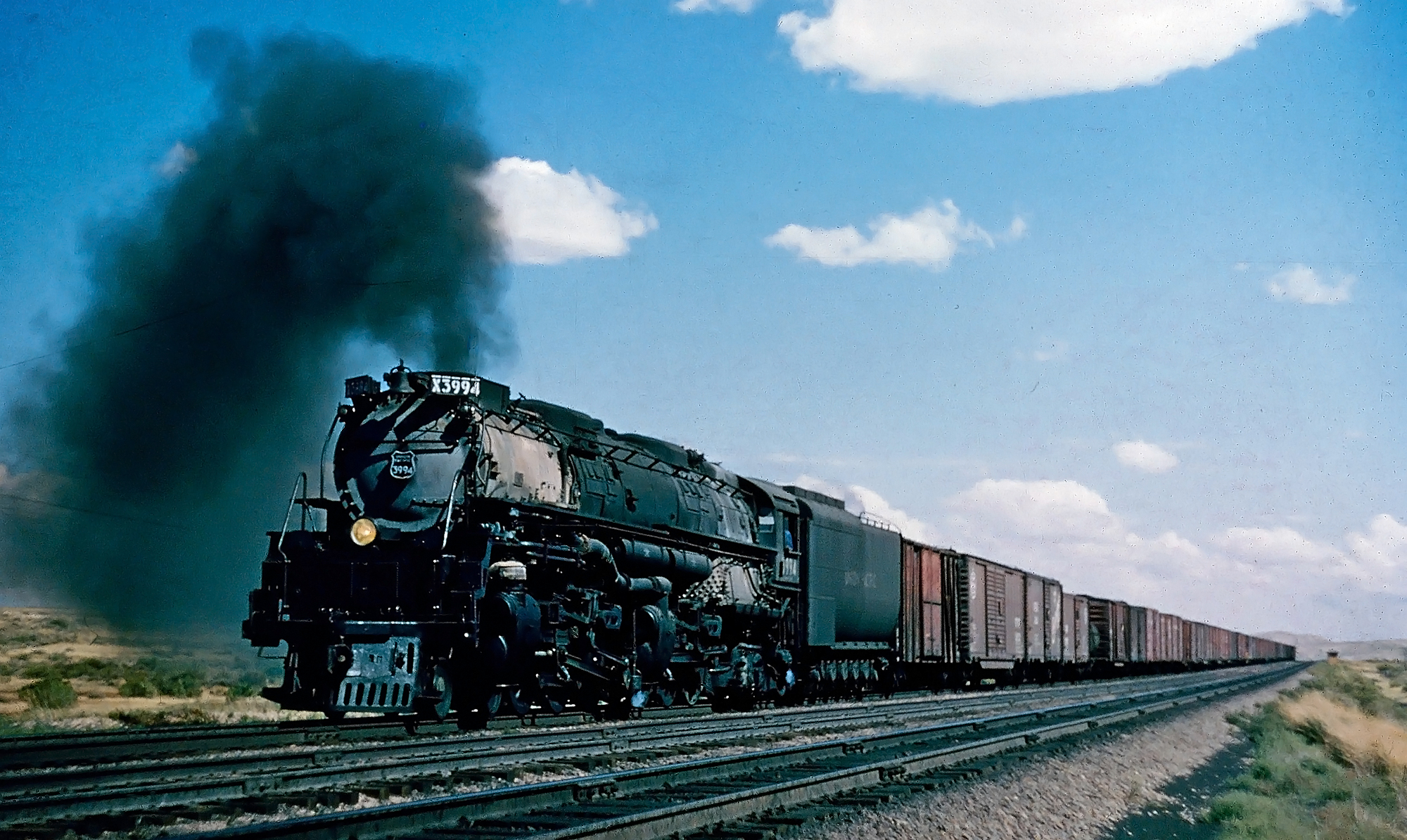 Union Pacific 4-6-6-4 #3994 is seen here in service near Kimball, Nebraska in August, 1956. Jim Hinkhouse photo. American-Rails.com collection.
Union Pacific 4-6-6-4 #3994 is seen here in service near Kimball, Nebraska in August, 1956. Jim Hinkhouse photo. American-Rails.com collection.History
The genesis of the Challenger was driven by UP's need for a more powerful locomotive that could efficiently manage the arduous demands of hauling trains across the formidable slopes of the Wasatch Mountain Range in western Utah.
During the mid-1930s, UP's Chief Mechanical Engineer Arthur H. Fetter and Assistant General Superintendent of Motive Power, Otto Jabelmann, felt that their existing fleet—notably 4-12-2 Overlands, 2-8-8-0s, and 2-10-2s—were increasingly inadequate for the evolving challenges of modern rail transportation.
This realization spurred the innovative development of the Challenger, marking a significant leap forward in locomotive design and capability.
Development
In collaboration with American Locomotive (Alco), Fetter and Jabelmann conceived the 4-6-6-4 wheel arrangement. This design emerged as an outstanding fusion of power and agility, excellently suited to meet the rigorous demands of UP's operational needs.
Arthur H. Fetter, a notable figure for his substantial contributions to advancements and innovations within UP's steam program, played a pivotal role in this development.
With the introduction of the Challenger, he championed an articulated design that not only attained higher speeds than the existing 4-12-2s but also successfully minimized the reciprocating weight, a critical factor that enhanced the locomotive's efficiency and performance.
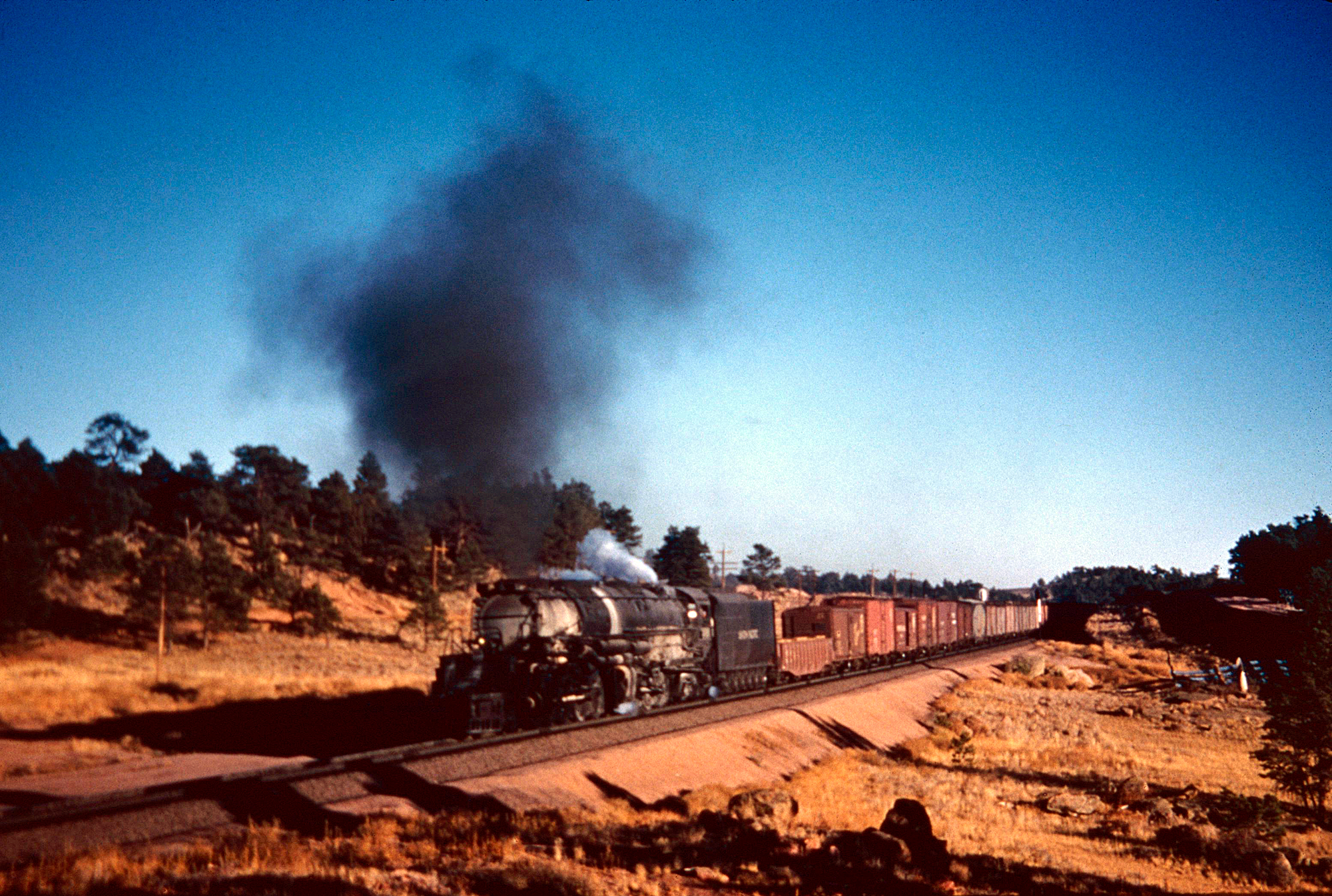 Union Pacific 4-6-6-4 #3986 steams west at Harriman, Wyoming on a summer evening in 1954. American-Rails.com collection.
Union Pacific 4-6-6-4 #3986 steams west at Harriman, Wyoming on a summer evening in 1954. American-Rails.com collection.Fetter and Alco began with an Overland design. The first prototype - #3900 - was ready for service on August 25, 1936, arriving in Council Bluffs, Iowa that day.
The 4-6-6-4 represented the zenith of steam locomotive innovation. It was equipped with state-of-the-art features including roller bearings on all axles—both engine and tender—a massive boiler, and a sizable firebox. These technological advancements made the Challenger not just a marvel of its time but also one of the most sophisticated steam locomotives ever constructed.
The inaugural test run of the new engine was an ambitious trek: it led an eastbound freight from Ogden, Utah to Green River, Wyoming, traversing the formidable Wasatch Range.
In a bold move to gauge the full capabilities of the new 4-6-6-4, officials decided to let the locomotive operate the round trip unassisted. Its performance during this rigorous test exceeded expectations, decisively proving its value and operational efficacy.
According to William Kratville's book "The Challenger Locomotives" Fretter, himself, stated the locomotive had "met the challenge" of the test and the name stuck.
In the succeeding years UP discovered these locomotives were extraordinarily versatile. Equally adept at hauling heavy, speedy freight trains over the challenging Wasatch and Sherman grades, they also excelled at propelling important passenger services.
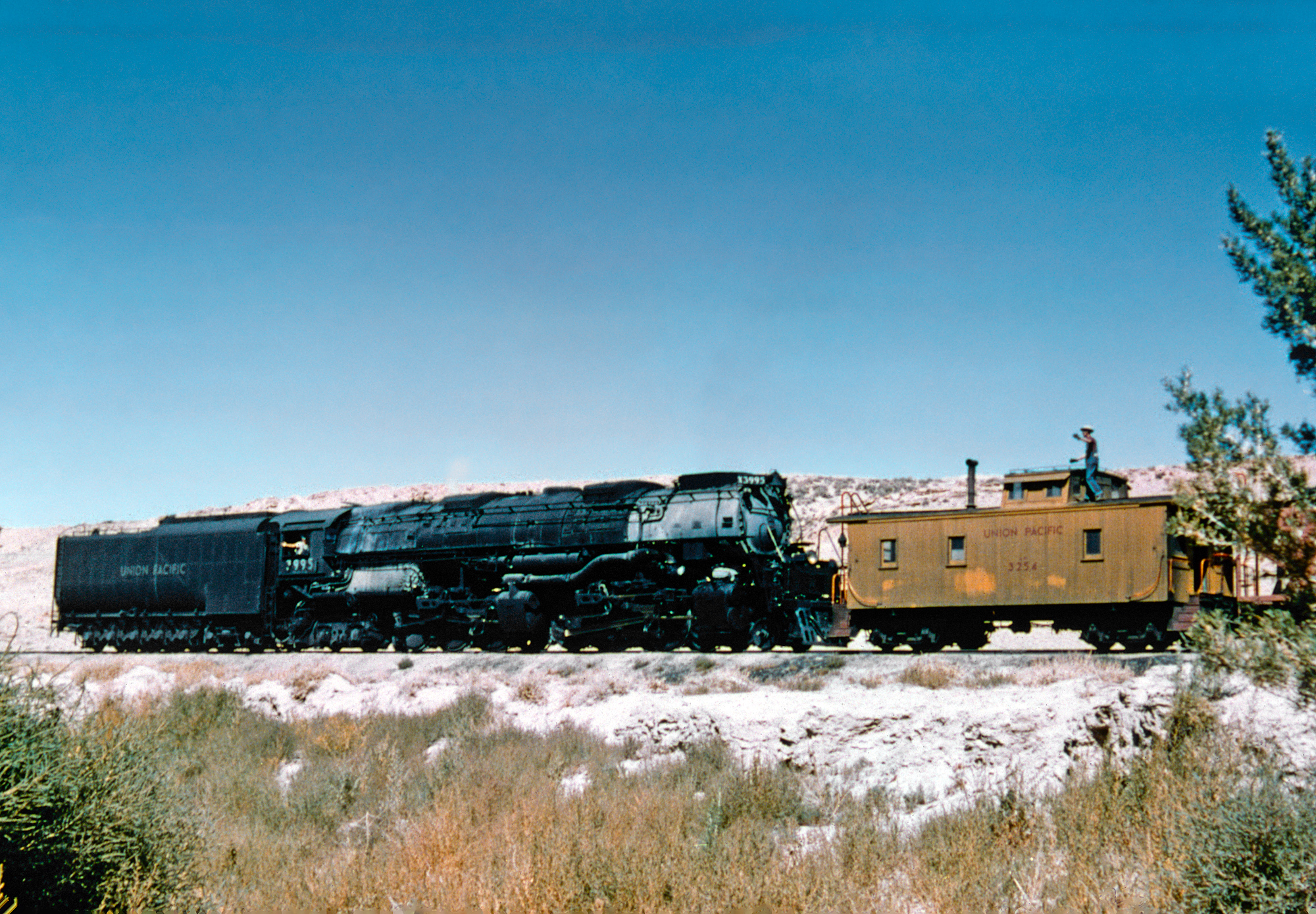 Union Pacific 4-6-6-4 #3995 switches the Winton Branch (Wyoming) on September 3, 1955. J.E. Shaw photo. American-Rails.com collection.
Union Pacific 4-6-6-4 #3995 switches the Winton Branch (Wyoming) on September 3, 1955. J.E. Shaw photo. American-Rails.com collection.Operators
- Clinchfield: Class E1 (8), E2 (4), E3 (6) – 18
- Delaware & Hudson: Class J – 40
- Denver & Rio Grande Western: Class L-105 (15), L-97 (6) – 21
- Great Northern: Class Z-6 – 2
- Spokane, Portland & Seattle: Class Z-6 (6), Z-8 (2) – 12
- Northern Pacific: Class Z-6/Z-7/Z8 - 47
- Union Pacific: Class CSA-1 (15), CSA-2 (25), 4664-3 (20), 4664-4 (25), 4664-5 (20) – 105
- Western Maryland: Class M-2 – 12
- Western Pacific: Class M-100 - 7
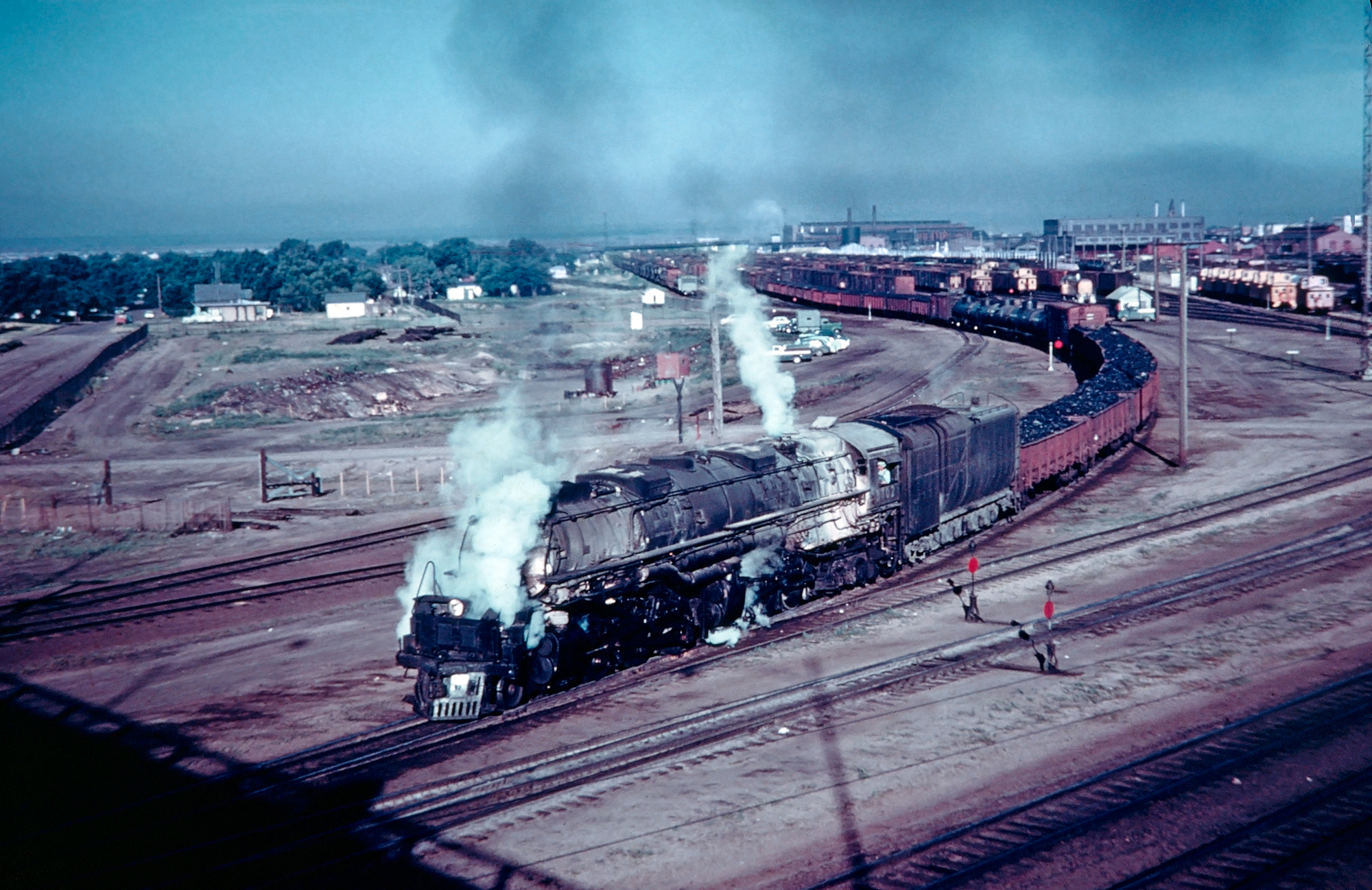 Union Pacific 4-6-6-4 #3702 in Cheyenne, Wyoming, circa 1958. This locomotive was formerly #3932 and converted to an oil burner in 1952. Richard Wallin photo. American-Rails.com collection.
Union Pacific 4-6-6-4 #3702 in Cheyenne, Wyoming, circa 1958. This locomotive was formerly #3932 and converted to an oil burner in 1952. Richard Wallin photo. American-Rails.com collection.Originally deployed on the Wasatch route, the Challengers were repositioned after the introduction of the more powerful Big Boys.
UP, recognizing the versatility of the engines, effectively employed the locomotives across its expansive network—from the rugged terrains of Oregon and California to the vast landscapes of Utah and Wyoming.
The utilitarian value of the 4-6-6-4s extended beyond Union Pacific as the eight other buyers of this model leveraged them for hauling heavy freights across steep grades.
Of the 252 Challengers constructed, the majority were manufactured by the American Locomotive Company (Alco), with Baldwin Locomotive Works contributing 27 units to the total fleet.
Railroads
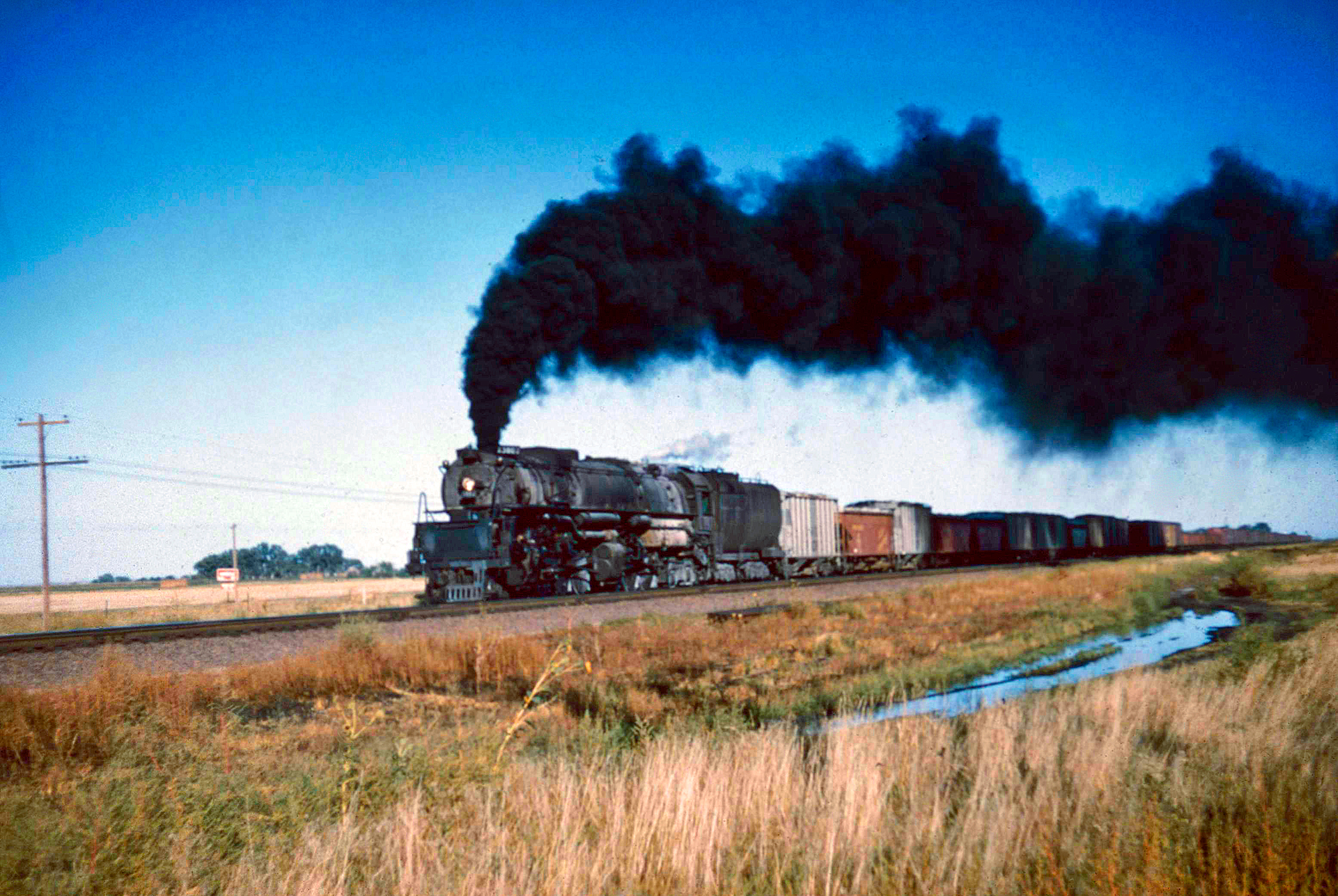 Union Pacific 4-6-6-4 #3802 hustles a long freight westbound near Lexington, Nebraska on September 15, 1950. American-Rails.com collection.
Union Pacific 4-6-6-4 #3802 hustles a long freight westbound near Lexington, Nebraska on September 15, 1950. American-Rails.com collection.Preservation
Of all the Challengers built, astonishingly only two remain preserved; Union Pacific #3985 and #3977. In addition, former Delaware & Hudson 1508's tender remains.
#3977 has been on display for many years in North Platte, Nebraska while #3985 operated as part of the Class I's steam program from 1981 until 2011.
Since that time it has awaited a major overhaul, which never came following the restoration of 4-8-8-4 #4014. It was announced in January, 2020 (retroactive to May, 2019) that #3985 was permanently retired.
In 2022 the big Challenger was donated to the Railroading Heritage of Midwest America, the major non-profit organization based in the old Rock Island shops in Silvis, Illinois. The organization plans to fully overhaul the locomotive and operate it in excursion service.
Today, along with sister #844, #4014 regularly chugs along the UP system on excursions and other promotional events. The Big Boy's phenomenal success in 2019 means it will be play a significant part in UP's steam program and public relations events moving forward.
If you have the opportunity I strongly recommend seeing one (or both) of these old girls in action, as large steam locomotives operating at-speed on main line railroads today is extremely rare.
Sources
- Griffin, James R. Rio Grande Railroad. St. Paul: Voyageur Press, 2003.
- Solomon, Brian. Baldwin Locomotives. Minneapolis: Voyageur Press, 2009.
- Solomon, Brian. Alco Locomotives. Minneapolis: Voyageur Press, 2009.
- Welsh, Joe and Holland, Kevin. Union Pacific Railroad. Minneapolis: Voyageur Press, 2009.
